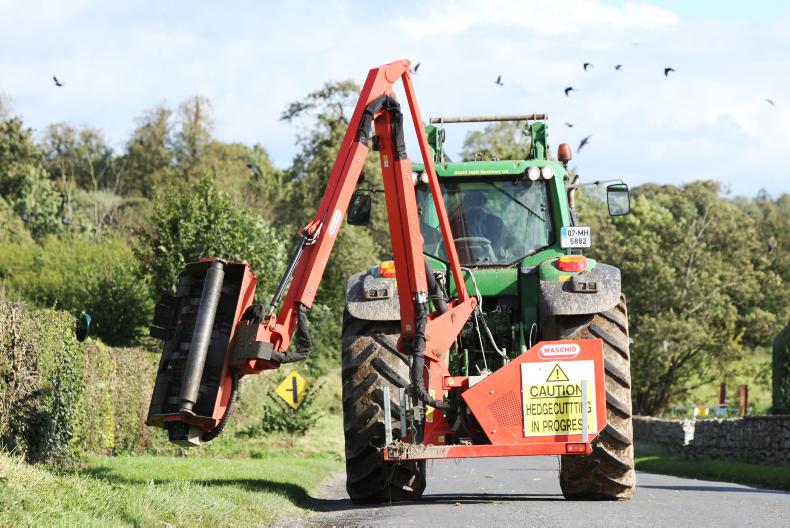Working on public roads
As hedge-cutting is often carried out on public roads, extra safety measures should be put in place. Passing traffic may not be aware of the dangers posed by flying debris or fallen objects on the road, so it is important that clear signage is used to alert them. These signs should be clearly visible and at a decent distance away from the actual hedge cutter, so that drivers can adjust their speed. If there is a risk of debris hitting passing traffic or pedestrians, always stop cutting and only resume when it is safe to do so. In areas with bad bends or narrow country roads that have limited visibility, for example, it may be necessary to put a flagman in place to slow oncoming traffic. In all cases, a risk assessment should be undertaken beforehand.
Tractor and implement
Unfortunately as we are all too aware, machinery is one of the biggest killers on Irish farms. Machinery has accounted for 21% of all fatalities in the last 10 years and hedge cutters pose no less of a risk than any other farm implement. With 42% of those fatalities coming as a result of being crushed by a machine, extra care should always be taken when hitching or unhitching the cutters. It is also important to check that hydraulic hoses are intact to avoid an injection of oil causing skin or tissue damage. Finally, the ground conditions should also be assessed where field work is being undertaken. Uneven or soft ground can increase the risk of the tractor overbalancing or overturning especially when the arm is extended.
Flying debris
When using either a circular saw or a flail cutters, there is always a high likelihood of debris firing off from the machine. This debris could potentially harm either the operator or someone in the vicinity of the work. In order to minimise the risk of this occurring, any guards or safety features on the machine, such as flail covers, should be intact. To help protect the operator from debris that may fly back in the direction of the cab, appropriate mesh or sheeting should be placed around the windows of the tractor. Appropriate PPP should also be worn – glasses, etc. Warning signs should be erected to alert people of the potential dangers and onlookers should be kept away from the operation.
Electricity pole stays
Stays can at times be a nuisance on farms. Given that they are placed at angles to vertical ESB poles they are in ditches or stick out into fields. This makes them an obstacle and a challenge to avoid when completing a task such as hedge-cutting. The reality is that stays are a vital part for the stability of an ESB pole and are equally as important. As there can be 1,000t of force at the top of an ESB pole to keep the wires tight and up over ditches and fields, something is needed to balance that force. Stays perform this vital task. In the event of a stay being damaged or broken, it will inflict a shock load on the pole which causes a great risk of the pole breaking and falling. Not only will this affect the electricity network it may also cause the pole to fall on the machine, as well as the risks associated with live wires on the ground.
Overhead lines
Many hedge cutters will have a reach-in of approximately 7m. Given this reach, and the area that hedge cutters normally operate in, they are at a high risk of making contact with overhead wires. The majority of boundary hedges along roads generally have ESB lines running over them.
These lines can hold 20,000 volts of power and making contact with one of these wires could have devastating consequences. Therefore, extra vigilance and care should be taken when operating in areas near overhead lines. This is especially true where poles may be damaged and wires are hanging lower than normal.
Emergency
If you make contact with an overhead wire do not leave the cab of the tractor. If possible, move away gently and call the ESB’s emergency number. If there is a high risk of the machine catching fire jump clear of the cab – do not step down.
Ensure to never make contact between the machine and the ground.
If your machine makes contact with an ESB line, call 1850 372 999.
All machinery capable of making contact with overhead lines should be fitted with warning signs in the cab to remind operators of what to do in an emergency.






 This is a subscriber-only article
This is a subscriber-only article
















SHARING OPTIONS: